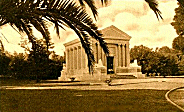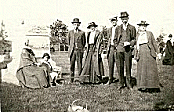




| Member of BannerPower Rotation System |





A Brief IntroductionAre there really cemetery postcards? Yes. People living in our taphophobic age are often surprised at the degree to which our ancestors not only honored the dead, but made their graves tourist destinations. Postcards appeared in the late nineteenth century. Chambers of commerce and tourism promoters found them a useful means of letting people know of local wonders. Cemeteries captured the popular imagination as places where one could go to reflect and enjoy the monuments. Visitors loved to share their discoveries with relatives. What has been left to posterity are a variety of paper ephemera which document the graveyards of the past and, sometimes, inscriptions on the stones themselves. |
Types of CardsTaphophiles can enjoy several kinds of postcards featuring cemeteries and related themes. Cards showing tombstones or prominent mausoleums have been sold to tourists for many years. Many of these cards come from New England, New Orleans, or Forest Lawn in California. In between these locations, one can find many local landmarks including famous graves, boot hills, and the odd family mausoleum. Advertising cards, circulated mostly within the mortuary industry, feature illustrations of chemicals, coffins, and other equipment necessary to the trade. Many taphophiles may find satisfaction collecting archaeology cards which show ancient cemeteries, artifacts collected from graves, tombs, sarcophagi, mummies, skeletons, etc. Finally, there are those cards which might best be described as "oddities": odd cadavers, joke cards such as a pair of vultures dining on a corpse, mummies which have been formed by the juxtaposition of different animal parts (e.g. mermaids -- a favorite of my own shows the dried torso of a monkey attached to the body of a crocodile), ossuaries, etc. |
Price and AvailabilitySome of the cards described above can be found on the racks of local tourist shops. A few cemeteries have their own gift shops where you can buy cards. Museums often carry cards showing grave items from their collections. These can cost the collector anywhere from a few cents to a dollar or more. Advertising cards are best collected through friends in the industry. Anyone who befriends a mortician can easily amass an impressive collection. Some people have formed online collector networks and exchanges. The older cards are found by haunting antique and used book stores, particularly those which specialize in paper ephemera. One can expect to pay anywhere from 25 cents upwards to the hundreds of dollars for vintage postcards. As a rule, cards become more expensive the closer they are to their place of origin. A Forest Lawn postcard, for example, will cost more in the Los Angeles area than in Boston. Dealers know this and often exchange cards with shop owners in other parts of the country. The best place to pick up that real photo card may be a place you find on your travels. The price of cards in online trading communities like eBay is generally more than their value in stores. Collectors have been known to go crazy when a pretty card hits the market. The final price in online auctions, however, may not be a reliable indicator of the true value of the card. One can both pay too much or get some real deals through these venues. Caveat emptor. |
Preserving Your Collection.Postcards can be stored either in appropriately sized photo albums or in plastic sleeves. The important rule of thumb is to avoid the use of materials made from polyvinyl-chloride (PVC). These will fade your cards (or photos). Light Impressions is a good source of non-PVC materials. Light Impressions offers a Postcard Storage Kit Some people have used postcards to create decoupage or framed them for wall display. |
An Incomplete Glossary
|

|
Light Impressions - The Leading Resource for Archival Supplies Questions or Comments? Return to the Taphophiles' Handbook |